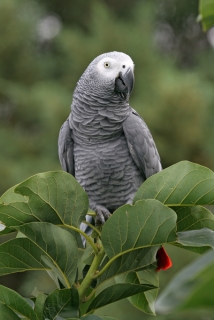Project Regions:
Grey Parrot |
|
|
Collaborators/Funders
Lukuru Foundation, Knoxville Zoo, Kenya Wildlife Service, Pandrillus Foundation, Last Great Ape Organization, Limbe Wildlife Centre, Lwiro Primate Rehabilitation Centre, Uganda Wildlife Education Centre, Disney Wildlife Rapid Response, Born Free Foundation, WWF Cameroon, Natural Encounters, Inc., Dees Family Foundation, Phoenix Landing Foundation, Columbus Zoo, Woburn Safari Park, Humane Society of the US (HSUS), Isdell Family Foundation, RSPCA, Pro Wildlife, Pan African Sanctuary Alliance (PASA), Ngamba Island Chimpanzee Sanctuary, Wildlife Conservation Society-Congo, Uganda Wildlife Authority, Bulgarian Ministry of Environment and Waters, MAYA, World Animal Protection (WAP)
Its popularity as a companion bird has led to heavy exploitation of the Grey Parrot.
Grey Parrots are endangered by illegal trafficking and extensive deforestation. They have declined or disappeared in Cameroon, Ghana, Kenya, Nigeria, Uganda, the Democratic Republic of the Congo and other African countries. Over 1.2 million wild-caught Grey and Timneh Parrots entered international trade in four decades. With a mortality rate of 40-60% during capture, the number trapped could be as high as three million.
How WPT makes an impact: Since 2001 WPT has been acting to prevent trade in Grey Parrots, supporting the rescue of thousands of Greys in west and central Africa. Further, WPT has mobilised the care and transport of Greys confiscated in eastern Europe to various zoos and sanctuaries. In 2016, collaboration with field partners produced new data which, along with a 75,000-signature petition, were presented at the Conference of the Parties for CITES 17. Delegates voted to transfer Grey Parrots to Appendix I, ending their commercial trade. The WPT and partners are now closely monitoring and reporting on online trade, as well as examining trade routes and visiting markets to research local impacts. In a number of countries, the WPT is helping to build rehabilitation capacity and provide training to care staff, and supporting communities in protecting key resources and nesting sites. In 2020, 39 rehabilitated Greys were released back to the wild in the Democratic Republic of the Congo for the first time and a further 63 were released recently.
Population: As few as 560,000, decreasing.
Vital statistics: Size: 33 cm (12.8 in) Weight: 400 g (14 oz)
Range: Grey Parrots are found in S Nigeria, S Central African Republic, Republic of Congo, DRC, Gabon, Equatorial Guinea, SE Ivory Coast, N Angola, S Democratic Republic of Congo, NW Tanzania, W Kenya, W Uganda, Principe and Bioko Islands.
Natural history: Seen in primary and secondary rainforest, clearings, mangroves, wooded savanna, cultivated land and gardens to an altitude of 2200 m (7216 ft). Diet includes fruits and seeds, particularly oil palm fruit. Flocks roost in palms over water or on islands in rivers. Breeding is January-February and June-July, E Africa; in other areas the dry season. Nest is a cavity in a tall living tree.
Project Updates
- PsittaScene Vol. 30.1, Spring 2018
- PsittaScene Vol. 28.2, Winter 2016
- PsittaScene Vol. 27.4, Winter 2015
- PsittaScene Vol. 26.3, Autumn 2014
- PsittaScene Vol. 25.4, Winter 2013
- PsittaScene Vol. 25.4, Winter 2013
- PsittaScene Vol. 25.4, Winter 2013
- PsittaScene Vol. 25.2, May 2013
- PsittaScene Vol. 24.2, May 2012
- PsittaScene Vol. 23.4, Nov. 2011
- PsittaScene Vol. 23.1, Feb. 2011
- PsittaScene Vol. 20.3, Aug. 2008
- PsittaScene Vol. 20.2, May 2008
- PsittaScene Vol. 20.1, Feb. 2008
- PsittaScene Vol. 20.1, Feb. 2008
- PsittaScene Vol. 14.2, May 2002
- PsittaScene Vol. 13.2, May 2001
WPT-sponsored research:
The wild bird trade and African parrots: past, present and future challenges
Trade in wild-sourced African Grey Parrots: insights via social media
Other publications:
Google scholar - Psittacus erithacus
Press releases/media:
- Press Release: Parrot Charity Rushes to Send Emergency Aid for Largest Group of Confiscated Parrots (PDF) Feb. 8, 2010
- The Illegal Trade Continues | FlyFree Feb. 2, 2010
- Parrots Released | FlyFree Dec. 2009
- Parrots counted: 503! | FlyFree Dec. 2009
- Massive Confiscation of 300 African Grey Parrots | FlyFree Nov. 2009


































